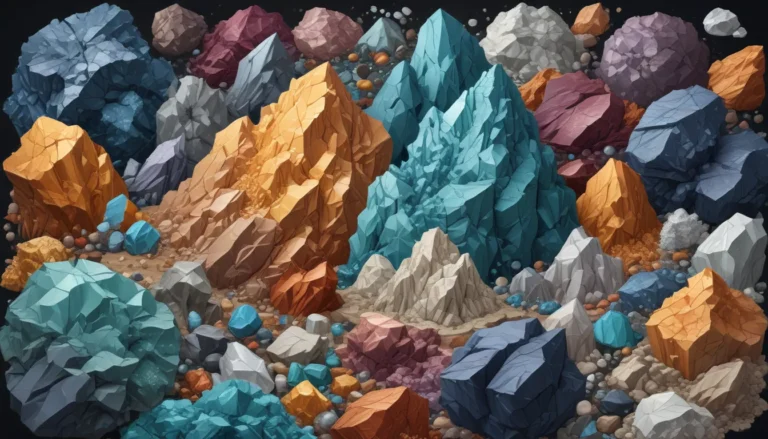A Note About Images: The images used in our articles are for illustration purposes only and may not exactly match the content. They are meant to engage readers, but the text should be relied upon for accurate information.
Dolomite, a captivating mineral with a rich history, has long piqued the interest of geologists, researchers, and nature enthusiasts. Its formation, unique properties, and practical applications make it a subject of great significance. In this article, we will delve into 15 fascinating facts about dolomite, shedding light on its geological importance, distinctive characteristics, and diverse uses. From its origins in ancient oceans to its role in agriculture and industry, dolomite’s story is as captivating as its stunning appearance. Join us on a journey through the intriguing world of dolomite as we uncover the mysteries and marvels that make it a truly remarkable mineral.
Key Takeaways:
- Dolomite is a versatile mineral named after a French mineralogist and is utilized in agriculture, construction, and manufacturing due to its diverse properties.
- Dolomite is a key source of magnesium, essential for agriculture, glass production, and oil and gas fields.
Dolomite: A Mineral, Not a Rock
Dolomite is a mineral composed of calcium magnesium carbonate and is commonly found in sedimentary rock formations. It forms in a rhombohedral crystal system and is a significant component of the Earth’s crust.
The Name Behind the Mineral: Dolomite
Named after the French mineralogist Déodat Gratet de Dolomieu, who first described it in 1791, dolomite owes its name to the Dolomite Alps, where it was studied.
A Colorful Display: Dolomite’s Range of Colors
Dolomite crystals can exhibit various colors, including white, colorless, pink, gray, and brown, due to impurities in its structure.
A Decorative Element: Dolomite as a Stone
Due to its pleasing appearance and ability to take a high polish, dolomite is commonly used as a decorative stone in architecture, countertops, flooring, and ornamental carvings.
Magnesium Source: Dolomite’s Role in Agriculture
Dolomite is an important source of magnesium, essential for plant growth, and is used in agriculture to neutralize soil acidity and provide nutrients to plants.
Marine Origins: The Formation of Dolomite
Dolomite often forms in marine environments, precipitating from magnesium-rich fluids interacting with calcium carbonate mud in shallow, warm seas.
A Pearly Appeal: Dolomite’s Lustrous Quality
Dolomite crystals can exhibit a pearly luster, adding to the mineral’s visual appeal and aiding in its identification.
Heat-Resistant Material: Dolomite in Refractory Bricks
Due to its high melting point and resistance to thermal shock, dolomite is utilized in the production of refractory bricks for high-temperature industrial processes.
Hydrothermal Formation: Dolomite’s Creation Process
Dolomite is frequently formed through hydrothermal processes, where hot mineral-rich fluids interact with existing limestone deposits, replacing the original mineral with dolomite.
Glass and Ceramics: Dolomite’s Contribution to Strength
Dolomite is a key ingredient in the production of glass and ceramics, enhancing their mechanical strength, durability, and lowering their melting point.
A Distinctive Property: Dolomite’s Reaction to Acid
When in contact with dilute hydrochloric acid, dolomite exhibits effervescence due to the release of carbon dioxide gas, aiding in its identification.
An Essential Rock: Dolomite in Oil and Gas Fields
Dolomite serves as an important reservoir rock in some oil and gas fields, acting as a host for hydrocarbons due to its porosity and permeability.
Dolostone: Dolomite’s Sedimentary Composition
Dolostone, also known as dolomite rock, is a sedimentary rock composed primarily of dolomite and is utilized in construction and road building.
The Dolomite Connection: Dolomite Mountains
The Dolomites, a mountain range in northeastern Italy, are primarily composed of dolomite rock, showcasing unique geological formations characteristic of dolomite-rich landscapes.
Dolomite’s diverse applications in various industries, from agriculture to construction, highlight its value as a valuable resource. Named after the French mineralogist Déodat Gratet de Dolomieu, this mineral’s rich history and versatile properties continue to make it a subject of fascination in the field of geology.
Conclusion
In conclusion, dolomite stands out as a fascinating mineral with a rich history and numerous practical applications. Its unique properties and chemical composition make it a valuable resource in agriculture, construction, and manufacturing. By understanding the facts about dolomite, we not only appreciate its geological significance but also recognize its importance in everyday life. Whether as a soil conditioner in farming or a crucial component in the production of glass and ceramics, dolomite plays a pivotal role in shaping our world. Embracing the diverse uses and characteristics of dolomite allows us to deepen our appreciation for the natural resources that contribute to the functionality and beauty of our surroundings.
FAQs
- What are the main uses of dolomite? Dolomite is utilized in various applications, including as a source of magnesium oxide, a soil conditioner in agriculture, and a component in ceramics and concrete manufacturing.
- Is dolomite the same as limestone? Dolomite and limestone, although both carbonate rocks, have distinct compositions, with dolomite containing magnesium in addition to calcium carbonate.
Explore the intriguing world of dolomite and its fascinating qualities, from its formation to its applications in different industries. Each fact about dolomite unravels a piece of its captivating story, showcasing the dynamic interplay between nature’s processes and the valuable resources that shape our world.






